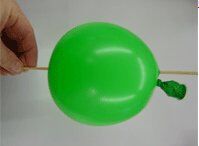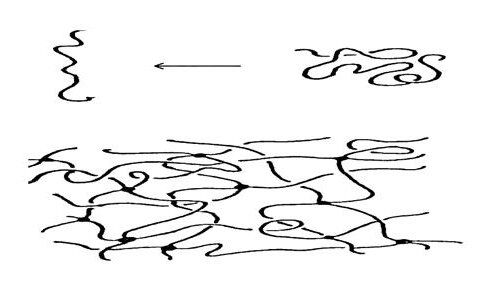Science experiments for children – Balloon skewer: this experiment, also called “kebab”, is simple and impressive. Try it: it works!
________________________
Science experiments for children – Balloon skewer
What do you need?
A balloon and a wooden stick for skewer.
Some can advise you to soak the skewers in water or oil or detergent, but in reality the dry skewer works fine: the balloon does not burst simply because it is drilled at two points where the polymers that compose it are more dense, and do not need more.
_______________
Science experiments for children – Balloon skewer
What to do?
Inflate the balloon so that its length is slightly less than the length of the skewer and close with the usual node.
You will notice that the balloon will present an area less tense around the node and at the apex of the opposite side (in these two areas the balloon is darker).
Take the skewer and all your trust in science and pass it before in the area less tense around the node (you feel out of the air, but the balloon will not burst) and then quickly get him out from the opposite side, always centering the area of rubber less tense (now not feel more air out).
The children will be truly amazed! It is a magic trick recommended at birthday parties …
http://www.fizzicseducation.com.au/
________________________
Science experiments for children – Balloon skewer
What happens?
The balloons are made of rubber, which is a polymer of isoprene.
The polymer chains are folded and bound together forming a network that has a high degree of flexibility.
Applying a force on this material, for example by inflating a balloon, the polymer chains, initially randomly oriented, relaxing thanks to the rotation around the bonds.
The fact that the chains are linked together in a network determines the elasticity of the rubber. The porosity of the rubber is demonstrated by the fact that the balloons slowly deflate.
An interesting demonstration of the properties of rubber is the trick, often used by magicians,
of the needle passing through the ball. The secret is to pierce the parts of the balloon in which the rubber molecules are below the minimum of stress or strain, that is, the ends of the balloon.
http://wwwcsi.unian.it/educa/pedagogia/
If you could see the rubber under the microscope, you would see many long strands or chains of molecules. These long strands of molecules called polymers.
Inflating the balloon these filaments of polymer chains relax.
Puncturing the balloon at a point where they are less strained, the long chains of molecules extend around the skewer and maintain the air inside.
____________________
Science experiments for children – Balloon skewer
Links
http://www.stevespanglerscience.com/
http://www.coolscience.org/CoolScience/
http://scifun.chem.wisc.edu/
http://sciencesquad.questacon.edu.au/ http://www.thenakedscientists.com/HTML/experiments/exp/balloon-kebab/ http://www.coolsciencedemos.com/2012/01/22/balloon-and-skewer/ http://www.education.com/activity/article/skewered_balloons/
http://www.physics.org/interact/physics-to-go/balloon-kebabs/ http://www.coolscience.org/CoolScience/KidScientists/balloonskewer.htm


